* You are viewing Posts Tagged ‘Animals’
James Brown
October 19, 2012
Conferences and Workshops, Events, Front Page, Podcasts, Project Updates, Publications
Tags: Animals, Charles Perrault, Comte de Buffon, Francis Willughby, Frogs, History of Medicine, History of Science, Insects, John Ray, Martin Lister, Natural History, Toads
The special issue publishes the proceedings of the day conference History Comes to Life: Seventeenth-Century Natural History, Medicine, and the New Science, organized by Anna Marie at The Royal Society in April (with the financial and logistical support of the project, The Royal Society, the Wellcome Trust, the John Fell Fund, and the BSHS). It features six fresh and fascinating articles from leading authorities on a wide range of topics at the intersection of seventeenth-century natural history, medicine, and science, including Buffon and animals, Francis Willughby and insects, and Jan Swammerdam’s abiding intellectual infatuation with frogs and toads. You can now enjoy early access to the articles online; the print version of the special issue will be available at the end of November. You can also listen to the podcasts from the conference. Congratulations to Anna Marie and the rest of the contributors!
James Brown
September 24, 2012
Events, Exhibitions, Lectures, Project Updates
Tags: Animals, Book History, Conchology, Gender, History of Science, Illustration, Martin Lister, Natural History, Seventeenth Century, Women
Post updated to include photographs
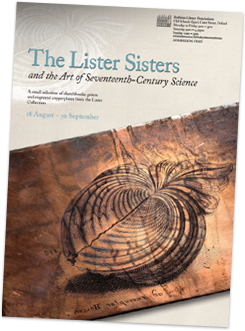 Our Martin Lister Research Fellow Anna Marie Roos has curated a small exhibition entitled ‘The Lister Sisters and the Art of Seventeenth-Century Science’, which will run in the Proscholium of the Old Bodleian Library from 18 August to 30 September (the poster can be downloaded here [pdf]). The free display showcases a unique set of drawings, prints, and copperplates of molluscs and their shells, (re)discovered among the library’s holdings by Anna Marie in 2010, which formed the basis for the illustrations in Martin Lister’s conchological magnum opus, the Historiae Conchyliorum (1685-92). Prepared by Lister’s teenage daughters, Susanna and Anna, the materials shed light on representational conventions within late seventeenth-century natural history, as well as on the gendered nature of illustrative practice in this boom era for lavishly illuminated scientific books. Anna Marie will also be giving a free lecture on ‘The Art of Science: The Rediscovery of the Lister Copperplates’ at 1pm on Wednesday 19 September in the Bodleian’s Convocation House (more info and booking on the library website). Further details of both events on The Conveyor.
Our Martin Lister Research Fellow Anna Marie Roos has curated a small exhibition entitled ‘The Lister Sisters and the Art of Seventeenth-Century Science’, which will run in the Proscholium of the Old Bodleian Library from 18 August to 30 September (the poster can be downloaded here [pdf]). The free display showcases a unique set of drawings, prints, and copperplates of molluscs and their shells, (re)discovered among the library’s holdings by Anna Marie in 2010, which formed the basis for the illustrations in Martin Lister’s conchological magnum opus, the Historiae Conchyliorum (1685-92). Prepared by Lister’s teenage daughters, Susanna and Anna, the materials shed light on representational conventions within late seventeenth-century natural history, as well as on the gendered nature of illustrative practice in this boom era for lavishly illuminated scientific books. Anna Marie will also be giving a free lecture on ‘The Art of Science: The Rediscovery of the Lister Copperplates’ at 1pm on Wednesday 19 September in the Bodleian’s Convocation House (more info and booking on the library website). Further details of both events on The Conveyor.
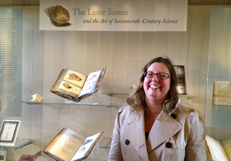
Anna Marie in front of the display

Lecturing in Convocation House
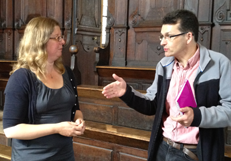
In conversation with Stephen Johnston
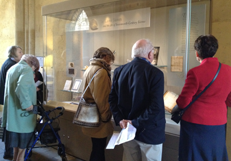
The exhibition proves a hit
James Brown
May 25, 2012
Events, Lectures, Podcasts, Project Updates
Tags: Animals, Conrad Gessner, Felix Platter, History of Science, Illustration, Natural History, Networks, Sixteenth Century
 Podcast available on the seminar page!
Podcast available on the seminar page!
 The zoological theme continued on Thursday 3 May when Florike Egmond from Leiden University (formerly of the Clusius Project) gave a talk in our seminar series entitled The Webs of Clusius and Gessner: Correspondence, Images, and Collecting in Sixteenth-Century Natural History. In a detailed and lavishly illustrated discussion, Florike described her recent discovery of two albums of original watercolour drawings created for the sixteenth-century Swiss naturalist Conrad Gessner (1551-1558) within the Special Collections of the University of Amsterdam.
The zoological theme continued on Thursday 3 May when Florike Egmond from Leiden University (formerly of the Clusius Project) gave a talk in our seminar series entitled The Webs of Clusius and Gessner: Correspondence, Images, and Collecting in Sixteenth-Century Natural History. In a detailed and lavishly illustrated discussion, Florike described her recent discovery of two albums of original watercolour drawings created for the sixteenth-century Swiss naturalist Conrad Gessner (1551-1558) within the Special Collections of the University of Amsterdam.
Crafted in Basel by the anatomist and natural historian (and Gessner’s friend) Felix Platter (1536-1614), the images – of a menagerie of marine life, mammals, reptiles, and amphibians, across 369 pages – formed the basis of many of the illustrations within Gessner’s zoological masterwork, the Historiae Animalium (1551-1558). You can find out more about this exciting discovery in Florike’s recent blog post for the Picturing Science network, and in her recent article for the Journal of the History of Collections.
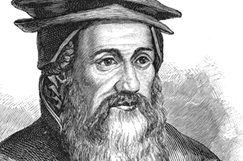
Conrad Gessner.
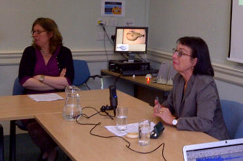
Anna Marie chairs Florike.
Renaissance correspondence networks, argued Florike, played a key role in sharing and disseminating (although not, curiously, in facilitating discussion of) manuscript images, as both Gessner, Clusius, and other naturalists solicited hand-drawn illustrations of animals to serve as the basis of woodcuts in their publications from colleagues and agents around the world. These exchanges, in turn, formed the basis of what Florike termed (with caveats) a kind of visual ‘canon formation’ within natural history, as elements of various portrayals were adapted, reworked, and reappropriated across different contexts and between media; as representational norms stabilized; and as the repertoire of animals deemed suitable for inclusion in zoological texts (whose wide remit originally encompassed familiar creatures such as cats and goats) was narrowed and standardized. A lively question and answer session focused on the artisanal communities responsible for producing the illustrations; how the works were commissioned and stored; and the frustrating but typical absence of any kind of discussion of manuscript images in the letters with which they circulated (resulting, suggested Florike, from the self-evident nature of enclosed materials).
Seminars take place in the Faculty of History on George Street on Thursdays at 3pm. For future talks in the series – and to listen to the podcast of Florike’s paper – please see the seminar webpage. All are welcome!
James Brown
May 14, 2012
Conferences and Workshops, Events, Exhibitions, Podcasts, Project Updates
Tags: Animals, Conchology, Frogs, History of Medicine, History of Science, Illustration, Insects, Martin Lister, Natural History, Ornithology, Royal Society, Seventeenth Century, Toads
Generously sponsored by the project, The Royal Society, The Wellcome Trust, the John Fell Fund, and the BSHS, sixty-three delegates attended the day-long event, which featured papers from eleven international authorities on early modern science. Speakers discussed everything from the views of French naturalists about the differences between dromedaries and camels, to the chequered history of the publication of the cabinet of natural curiosities of Albertus Seba, to the ornithology of Francis Willughby and John Ray and the scientific representation of frogs and toads.

Helen Watt, our Lhwyd researcher.

Perusing the exhibition.

Anna Marie talks to Jill Lewis.

Early modern ornithologies.
There was a concomitant exhibition in the Royal Society’s Marble Hall, also curated by Anna Marie, featuring a display of relevant books from the Society’s collections; highlights were a bear paw clam displayed alongside its illustration by Lister’s daughters in his Historiae Conchyliorum (1692-97), and John Ray’s Historia Plantarum, in which Ray deployed the terms ‘petal’ and ‘pollen’ for the first time. In a further exciting output, Anna Marie will guest edit a special conference issue of Notes and Records of the Royal Society (December 2012) dedicated to the complex interplay between seventeenth-century medicine and natural history. Dovetailing out from Lister’s own contributions, the special issue will consider to what extent practices and technologies of natural history changed between the Renaissance and the seventeenth century, and will explore how the acquisition of knowledge concerning the natural world and new taxonomies affected the perception and treatment of beasts for medical and experimental use.
James Brown
January 11, 2012
Conferences and Workshops, Events, Project Updates
Tags: Animals, Arachnology, Conchology, History of Science, Martin Lister, Natural History, Royal Society, Seventeenth Century
Update: see write-up, photos, and podcasts
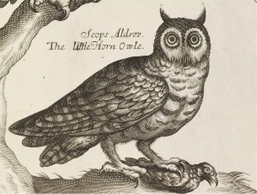
A seventeenth-century rendering of a little horn (or screech) owl.
A day conference on History Comes to Life: Seventeenth-Century Natural History, Medicine and the New Science‚ will be held on Friday 27 April 2012 from 9am to 5.30pm at The Royal Society in London. Organised by our industrious Martin Lister (1639-1712) Research Fellow Anna Marie Roos, and held to commemorate the 300th anniversary of Lister – Royal Physician and the first arachnologist and conchologist – the event will explore the often neglected relationship between medicine and natural history in the seventeenth-century. Featuring an exciting line-up of ten international authorities on early modern science, the meeting will dovetail out from Lister’s work to consider to what extent practices and technologies of natural history changed between the Renaissance and the seventeenth century. It will also explore how the acquisition of natural history knowledge and new schemes of taxonomy influenced the perception and treatment of animals for medical and experimental use. As well as support from Cultures of Knowledge, the conference is sponsored by The John Fell Fund, The British Society for the History of Science, The Royal Society, and the Wellcome Trust. The conference fee is a bargain at £40 (full price) or £30 (student/unwaged). For further details and to register online, please visit the conference webpage. Please address queries to felicity.henderson(at)royalsociety.org.
 Our pertinacious (we’re running out of adjectives) Martin Lister Research Fellow – and recent inductee of the Linnean Society – Anna Marie Roos has guest-edited a special issue of the prestigious journal Notes and Records of the Royal Society.
Our pertinacious (we’re running out of adjectives) Martin Lister Research Fellow – and recent inductee of the Linnean Society – Anna Marie Roos has guest-edited a special issue of the prestigious journal Notes and Records of the Royal Society.





 The
The 







 Join
Join 